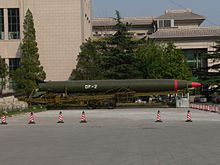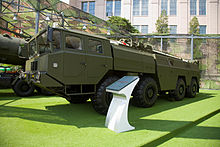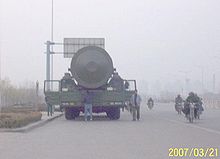- Dongfeng (missile)
-
The Dongfeng (Chinese: 东风; literally "East Wind") missile is a series of intermediate and intercontinental ballistic missiles operated by the People's Republic of China. Typically, the word Dongfeng is shortened to "DF", so Dongfeng 9 is written as DF-9.
Contents
History
After the signing of Sino-Soviet Treaty of Friendship, Alliance, and Mutual Assistance in 1950, the Soviet Union assisted China's military R&D with training, technical documentation, manufacturing equipment, and license-production of Soviet weapons. In the area of ballistic missiles, the Soviets transferred R-1 (SS-1), R-2 (SS-2), and R-11F to China.[1] The first Chinese ballistic missiles were based on Russian design, which was originally based on the German V-2 rocket. Since then, China has made many advances in its ballistic missile and rocket technology. The space-launch Long March rocket has its roots in the Dong Feng missile.
Dongfeng missiles
Dongfeng 1 (SS-2)
First of the Dong Feng missiles, the DF-1 was a licensed copy of the Soviet R-2 (SS-2) Sibling missile.[2] The DF-1 had a single RD-101 rocket engine, and used alcohol for fuel with liquid oxygen (LOX) as an oxidizer. The missile had max range of 550 km and 500 kg payload. Limited numbers of DF-1 were produced in the 1960s, and have since been retired.[1]
Dongfeng 2 (CSS-1)
 A Dongfeng 2 (CSS-1) at the Beijing military museum
A Dongfeng 2 (CSS-1) at the Beijing military museum
The DF-2 is China's first medium-range ballistic missile, with 1,250 km range and 15-20 kt nuclear warhead. It received the western designation of CSS-1, CSS means China Surface-to-Surface (missile).[3] Some western observers claim that the DF-2 is a copy of the Soviet R-5 (SS-3) SHYSTER, as they have similar range and payload.[4] Others attribute the design to Chinese specialists Xie Guangxuan, Liang Sili, Liu Chuanru, Liu Yuanwei, Lin Shuangwei, and Ren Xinmin. The first DF-2 failed in its launch test in 1962, leading to the improved DF-2A. The DF-2A was used to carry out China's first nuclear ballistic missile test at Lop Nor in 1966, and was in operational service since late 1960s. All DF-2 were retired from active duty in the 1980s.[5]
Dongfeng 3 (CSS-2)
Main article: DF-3AThe DF-3 is often considered China's first "domestic" intermediate-range ballistic missile (IRBM). After the Soviets refused to provide China with R-12 (SS-4) missile design, China decided to develop their own IRBM in early 1960s.[6] The design has been attributed to both Tu Shou'e [屠守锷] and Sun Jiadong [孙家栋], and the missile as produced at Factory 211 (Capital Astronautics Co. [首都航天机械公司], also known as Capital Machine Shop [首都机械厂]. The 2,500 km DF-3 was originally designed with 2,000 kg payload to carry an atomic (later thermonuclear) payload. A further improved DF-3A with 3,000 km range (~4,000 km with reduced payload) was developed in 1981, and exported to Saudi Arabia with conventional high-explosive warhead.[7] Most DF-3/DF-3A's have been retired, with 30-40 remaining and scheduled to be replaced by DF-21.[8]
Dongfeng 4 (CSS-3)
Main article: DF-4The DF-4 "Chingyu" is China's first two-stage ballistic missile, with 5,550-7,000 km range and 2,200 kg payload (3 Mt nuclear warhead). It was developed in late 1960s to provide strike capability against Moscow and Guam. The DF-4 missile also served as basis for China's first space launch vehicle, Chang Zeng 1 (Long March 1). Approx. 20 DF-4's remain in service, and are scheduled to be replaced by DF-31 by 2010-2015.[9][10]
Dongfeng 5 (CSS-4)
Main article: DF-5The DF-5 is an intercontinental ballistic missile (ICBM), designed to carry a 3 megaton (Mt) nuclear warhead to distance up to 12,000 km. The DF-5 is a silo-based, two-stage missile, and its rocket served as the basis for the space-launch vehicle Fengbao-Tempest (FB-1) used to launch satellites. The missile was developed in the 1960s, but did not enter service until 1981. An improved variant, the DF-5A, was produced in the mid 1990s with improved range (>13,000 km). Currently, an estimated 24-36 DF-5A's are in service as China's primary ICBM force.[11][12]
Dongfeng 11 (CSS-7)
Also known as the M-11 (export), the DF-11 is a road-mobile short-range ballistic missile (SRBM) designed by Wang Zhenhua at the Sanjiang Missile Corporation (also known as the 066 Base) in the late 1970s. The DF-11 has range of 300 km and 800 kg payload. An improved DF-11A version has increased range of >825 km.[13] China is known to have exported DF-11s to Pakistan, which served as the basis for the Shaheen-1 and Shaheen-2 missiles. The range of the M-11 does not violate the limits set by the Missile Technology Control Regime (MTCR). Unlike previous Chinese ballistic missiles, the DF-11 use solid fuel, which greatly reduces launch preparation time (15-30 min). Liquid-fueled missiles such as the DF-5 require up to 2 hours of pre-launch preparation. Estimates on the number of DF-11s in service vary between 500 to 600.[14][15]
Dongfeng 15 (CSS-6)
Main article: DF-15Also known as the M-9 (export), the DF-15 was developed by the CASC China Academy of Rocket Motor Technology (ARMT), previously known as the 5th Aerospace Academy. The missile is a single-stage, solid-fuel SRBM with 600 km range and 500 kg payload. During the 1995-1996 Taiwan strait crisis, the PLA launched 6 DF-15's in an "exercise" to demonstrate the missile's capability. Although the DF-15 is marketed for export, its range would violate the Missile Technology Control Regime (MTCR) agreement, and thus no DF-15 has been exported to date. Approx. 300-350 DF-15's are in service with the PLA Second Artillery Corps today.[16][17]
Dongfeng 21 (CSS-5)
Main article: DF-21The DF-21 is a two-stage, solid-fuel, medium-range ballistic missile (MRBM) developed by the 2nd Aerospace Academy (now China Changfeng Mechanics and Electronics Technology Academy) in late 1970s. It was the first solid-fueled ballistic missile deployed by the Second Artillery Corp. The missile carries a single 500 kt nuclear warhead, up to 2,500 km range. The DF-21 also served as the basis for the submarine-launched ballistic missile (SLBM) JL-1 (CSS-N-3),[18] used on the XIA-Class SSBN. In 1996, an improved variant, the DF-21A, was introduced. Currently, an estimated 60-80 DF-21/DF-21A are in service.[19][20]
Dongfeng 25
Main article: DF-25The mobile-launch DF-25 was a two-stage solid-fuel missile with a range of 1,700 kilometers. Development was cancelled in 1996.
Dongfeng 31 (CSS-10)
Main article: DF-31The DF-31 is China's newest road-mobile, solid-fuel ICBM developed by the 4th Aerospace Academy (now Academy of Rocket Motor Technology / ARMT). The DF-31 has range of 8,000+ km, and can carry a single 1,000 kt warhead, or up to three 20-150 kt MIRV warheads. An improved version, the DF-31A, has range of 12,000+ km. The DF-31 was developed to replace many of China's older ballistic missiles, and served as basis to the new JL-2 (CSS-NX-4/CSS-NX-5) SLBM. Approx. 30 DF-31/DF-31A are estimated to be in service.[21][22]
Dongfeng 41 (CSS-X-10)
Main article: DF-41Western analysts speculate that China may be developing a next-generation ICBM, known as the DF-41, with 12,000-14,000 km range, armed with single, 3, 6, or even 10 MIRV warheads. DF-41 has yet to be displayed in public.[23]
References
- ^ a b DF-1 GlobalSecurity.org
- ^ R-2 / SS-2 SIBLING GlobalSecurity.org
- ^ DF-2 / CSS-1 GlobalSecurity.org
- ^ R-5 / SS-3 SHYSTER GlobalSecurity.org
- ^ DongFeng 2 (CSS-1) Intermediate-Range Ballistic Missile Sinodefence.com
- ^ DF-3A / CSS-2 GlobalSecurity.org
- ^ http://www.missilethreat.com/missilesoftheworld/id.3/missile_detail.asp
- ^ DongFeng 3 (CSS-2) Intermediate-Range Ballistic Missile Sinodefence.com
- ^ DF-4 (the "Chingyu" missile) GlobalSecurity.org
- ^ DongFeng 4 (CSS-3) Intermediate-Range Ballistic Missile Sinodefence.com
- ^ DF-5 GlobalSecurity.org
- ^ DongFeng 5 (CSS-4) Intercontinental Ballistic Missile Sinodefence.com
- ^ http://www.softwar.net/dongfeng.html
- ^ DF-11 (CSS-7) GlobalSecurity.org
- ^ DongFeng 11 (CSS-7) Short-Range Ballistic Missile Sinodefence.com
- ^ DF-15 (CSS-6 / M-9) GlobalSecurity.org
- ^ DongFeng 15 (CSS-6) Short-Range Ballistic Missile Sinodefence.com
- ^ JuLang 1 (CSS-N-3) Submarine-Launched Ballistic Missile Sinodefence.com
- ^ DF-21 / CSS-5 GlobalSecurity.org
- ^ DongFeng 21 (CSS-5) Medium-Range Ballistic Missile Sinodefence.com
- ^ DF-31 GlobalSecurity.org
- ^ DongFeng 31A (CSS-9) Intercontinental Ballistic Missile Sinodefence.com
- ^ DF-41 Intercontinental Ballistic Missile Sinodefence.com
External links
 Missiles of the People's Republic of China
Missiles of the People's Republic of ChinaSurface-to-
SurfaceBallistic Missiles- M20
- B-611
- P-12
- BP-12
- BP-12A
- Type 621
- Type 631
- DF-15 (M-9)
- DF-11 (M-11)
- DF-1
Anti-Ship- DF-21D[1]
- DH-2000
- HN-2000
- CJ-20
- CJ-10
- DH-10
- CF-2
- CF-1
- HN-3
- HN-2
- HN-1
- YJ-85 (C-805)[1]
- YJ-12
- YJ-22
- YJ-7 (C-701)
- C-703
- YJ-62 (C-602)
- KD-88
- YJ-4
- KD-63
- YJ-63 (C-603)
- YJ-2
- YJ-1
- C-611
- XW-41
- DH-2000
- HN-2000
- YJ-91
- YJ-83 (C-803)
- FL-7
- HY-3 (C-301)
- FL-2 (C-101)
- CJ-1
- YJ-12
- YJ-22
- 3M-80MBE/E Moskit (SS-N-22)
- 3M-54E/E1 Klub (SS-N-27)
- C-302
- C-303
- YJ-2
- YJ-1
- YJ-82 (C-802)
- YJ-8 (C-801)
- C-704
- YJ-7 (C-701)
- FL-10
- C-703
- YJ-62 (C-602)
- TL-10
- FL-8
- TL-1
- TL-2
- TL-6
- FL-9
- SY-2
- SY-1
- HY-4 (C-401)
- HY-2 (C-201)
- HY-1
- C-611
- XW-41
- LJ-7 · HJ-10
- HJ-9
- HJ-8
- HJ-73
- 9K116 Bastion
- J-202
- J-201
- 265-I
Air-to-
Surface- YJ-2
- YJ-1
- C-611
- XW-41
- YJ-22
- YJ-12
- BA-7
- AKD-10
- AR-1
- YJ-85 (C-805)[1]
- C-704KD
- YJ-7 (C-701)
- C-703
- YJ-62 (C-602)
- KD-88
- KD-63
- YJ-63 (C-603)
- Kh-59
- Kh-29
- YJ-4
- QW-1
- DH-2000
- HN-2000
- YJ-91
- YJ-83 (C-803)
- FL-7
- HY-3 (C-301)
- FL-2 (C-101)
- CJ-1
- YJ-12
- YJ-22
- 3M-80MBE/E Moskit (SS-N-22)
- 3M-54E/E1 Klub (SS-N-27)
- C-302
- C-303
- YJ-2
- YJ-1
- YJ-82 (C-802)
- YJ-8 (C-801)
- C-704
- YJ-7 (C-701)
- FL-10
- C-703
- YJ-62 (C-602)
- TL-10
- FL-8
- TL-1
- TL-2
- TL-6
- FL-9
- SY-2
- SY-1
- HY-4 (C-401)
- HY-2 (C-201)
- HY-1
- C-611
- XW-41
- Kh-35
- GB-1
- LS series
- LT series
- FT series
- YZ-100 series
- YZ-102 series
- YZ-200 series
- KAB-1500Kr
- KAB-500Kr
Surface-to-
Air- FJ
- KT-1
- KT-2
- KT-III
- HQ-18
- S-300PMU-2
- HQ-15
- S-300PMU-1 (HQ-10)
- HQ-9
- KS-2
- KS-1
- HQ-12
- HQ-19
- HQ-18
- S-300PMU-2
- HQ-15
- S-300PMU-1 (HQ-10)
- HQ-9
- FD-2000
- S-300PMU
- S-300FM
- HQ-12
- KS-1
- KS-2
Man Portable SAMsAir-to-Air Beyond Visual Range AAMs- PL-21
- PL-12 (SD-10)
- PL-10 (K/AKK-10)
- PL-10
- PL-11
- PL-4
- Notes: [1] Under development
- See also: People's Liberation Army
Categories:- Ballistic missiles of the People's Republic of China
- Cold War weapons of China
Wikimedia Foundation. 2010.


